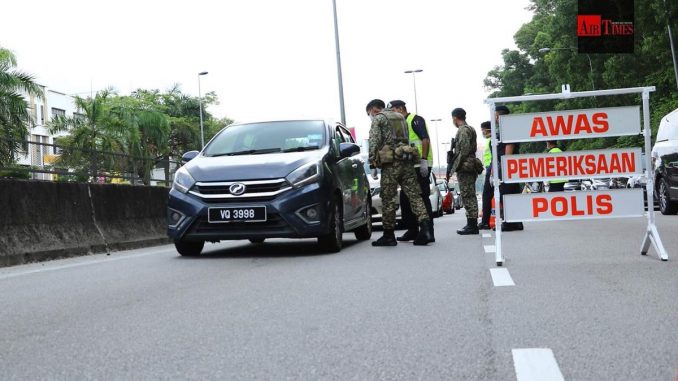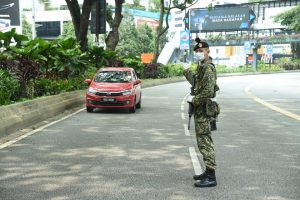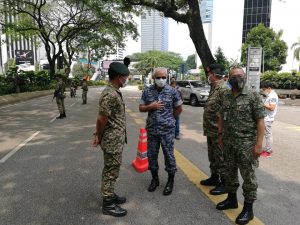
SHAH ALAM: Out in the streets. The military has begun deploying their units to the streets today to assist the police in ensuring the public obey the Movement Control Order enforced since March 18 to March 31. The military was deployed as part of the whole government approach in ensuring the MCO as part of the battle against COVID-19 pandemic.
And before you get knickers twisted, the military has only deployed some 7,500 personnel nationwide, as announced by the CDF. The 7,500 personnel are part of the 50,000 strong force deployed for the MCO,including the police, Rela, local authorities enforcement officers and even civil defence personnel.

A soldier manning road block at Jalan Ampang today. Markas ATM
Of course the military personnel deployed are carrying their rifles, M4s, as does the police. armed either with their service handguns or sub-machine guns. Only RELA and enforcement officers will not be armed as they are never equipped with firearms, almost 99 per cent of the time.
So what are these personnel doing when they are deployed? Well according to Defence Minister Ismail Sabri”
The Malaysian Armed Forces will be helping the police in patrol duties, conducting road blocks, monitoring hospitals, rural and border areas and other high risk public areas. Angkatan Tentera Malaysia (ATM) akan membantu Polis Diraja Malaysia (PDRM) dalam mengadakan rondaan, sekatan jalanraya, mengawal hospital dan sempadan, kawasan luar bandar dan kawasan-kawasan awam yang berisiko tinggi.
• RELA and Civil Defence personnel are also helping to conduct similar duties in rural areas. Bantuan pihak Jabatan Sukarelawan Malaysia (RELA) dan Angkatan Pertahanan Awam (APM) juga digerakkan terutamanya di kawasan luar bandar.
• The police has established a special committee to ensure the effectiveness of the joint operations. PDRM telah menubuhkan satu Jawatankuasa Khas (Special Task Force) bersama ATM, RELA dan APM. SOP penglibatan bersama agensi akan ditentukan oleh Jawatankuasa Khas ini.
• The government hoped the joint enforcement will ensure proper compliance of the public. Kerajaan berharap penglibatan bersama ini dapat meningkatkan lagi kesedaran dan pematuhan Perintah Kawalan Pergerakan dalam kalangan rakyat Malaysia.
The public is advised not to be taken in by pictures of tanks and armoured personnel carriers in the streets. This is fake news. Rakyat dinasihatkan supaya jangan percaya dengan gambar-gambar yang tular memaparkan kononnya kereta kebal dan kereta perisai ATM bergerak di atas jalan raya. Ini merupakan tindakan yang tidak bertanggungjawab oleh pihak yang ingin menimbulkan keresahan pihak awam

CDF Gen Affendi Buang checking a road block manned by soldiers at Jalan Ampang today. Markas ATM
— Malaysian Defence
If you like this post, buy me an espresso. Paypal Payment

Askar wataniah is also deployed
http://m.facebook.com/story.php?story_fbid=10158315318075555&id=188457585554
Reply
Likely full time reservists as they are from the Sg Buloh Camp
What exactly are “full time” reservists?
The available literature says RAW formerly consisted of two categories of resrevists: 300 series battatlions (described as “mobilised” and presumably your “full time” reservists, supposedly having been recategorized as Regimen Sempadan) and 500 series battalions (described as “volunteer”). As often as these terms are used, there is not the slightest elaboration on them.
Reply
These are regulars assigned to the AW units as core personnel. Many started as reservists but ended up as regulars (some remained as full time reservists until permanent slot opens) for this units to replace those who retired. Not many regulars, want to be sent to these units for obvious reasons.
Just thinking out loud.
IMO this is the perfect time, for our military to really practice NBC capability in real world situations. All of our NBC capable teams should now deploy and practice what training that they have gotten. This is also a good time to practice our C2 capability for urban scenarios. Try put all kinds of small drones to see which one is good enough for us. Try out using drones for various tasks, try tracking a car for example. Put out small teams to practice urban maneuvers while helping out to enforce MCO.
Look at this as opportunities to do things that we cannot do in normal situations.
Reply
on the NBC units, to do what really? They are set up for combat operations, not for civil emergencies.
“IMO this is the perfect time, for our military to really practice NBC capability in real world situations.”
Liew Chin Tong wrote on the relevant MAF capabilities.
https://www.theedgemarkets.com/article/liew-chin-tong-deployment-malaysian-armed-forces
To me, the situation calls for not only exercising the delivered capabilities, but also for us to exercise them in new, compartmentalised concepts of operations to prevent the spread of disease within/between units. This is not something usually practiced, but should be because future outbreaks of disease can coincide with outbreaks of hostilities. We should continue to practice them after the current need passes.
On the drones,PDRM & ATM is using quadcopter-types, maybe concentrated usage first in Klang Valley so hopefully you guys over there can find out more. Operators and C2 I’m not sure what outfit is it for both PDRM & ATM.
https://www.airtimes.my/2020/03/24/atm-pdrm-aturgerak-dron-pantau-perintah-kawalan-pergerakan-hari-ini/
@ Marhalim
The ATM currently has the biggest stock of HAZNAT/NBC suits available. What they can do now is to familiarize as many personnel as possible in the use of those suits, while helping out to enforce the MCO. Tasks that can use those suits and NBC equipments:
– decontamination of public spaces and areas with confirmed covid-19 infection
– handling of bodies of covis-19 cases
– security of important places already evacuated because of confirmed covid-19 in that place.
– security of covid-19 quarentine areas
– transferring covid-19 infected persons from one place to another.
@ AM
Yes, the unique situation right now must be fully utilised to confirm existing procedures and study new ones. This situation right now wont probably be experienced in the next 100 more years.
“This situation right now wont probably be experienced in the next 100 more years.”
It’s practically guaranteed to happen again over the next century, more so if the world does not learn from its mistakes. Hence the need to practice both war and MOOTW scenarios against the background of an ongoing pandemic.
“The ATM currently has the biggest stock of HAZNAT/NBC suits available. What they can do now is to familiarize as many personnel as possible in the use of those suits, while helping out to enforce the MCO.”
There is a lot of difference between operating on a battlefield with NBC agents and practicing good hygiene in paper masks while supporting the MCO. It is not necessary to wear expensive MOPP suits, neither is it fun in this weather. Considering our record, I don’t expect that we have very many.
Marhalim:
Thank you very much for explaining a years-long enigma to me. No thanks to the sorry state of literature on our military that parrots those two terms without explanation.
“Look at this as opportunities to do things that we cannot do in normal situations.”
Certain units in the military can surely perform civil support duties. The question is whether they should be borne by the military, by police units or another agency.
Reply
The military unit can do it but its endurance is limited as war remains its utmost duty
What the Royal Engineer’s NBC Wing can do and what it should do are 2 very profoundly different things.
In the very first place how large is the unit and how much NBC kit does it actually have? Given that the whole purpose of having the NBC Wing was to enable us to have a basic NBC capability and the basic knowledge needed to deal with such a threat; I would assume the Wing is small and it has limited numbers of detector kits, decontamination kits, gas masks, suits, etc. It used to have Avon S-10 gas masks but it has been replaced with a newer design (the S-10 has also been replaced in British service). When the Wing was established almost everything sourced was British and similar to what the British army issued.
The Philippines’s army also has a small NBC unit and it has been deployed to assist health authorities. Our if the original ASEAN 6; the first army to have a NBC unit was the RTA.
P.S. If I had to hazard a guess; the Ministry of Health and Environment has far more HAZMAT suits than the army has NBC suits. Furthermore non military gas masks are just as effective as military one’s; despite not being ‘military spec”; the only difference is they won’t have drinking tubes.
Gas masks actually have a long shelf life. What is needed to be changed are their filtres which are inexpensive and easily available; i.e. a S-6 made in the 1980’s – as long as the rubber has no cracks – is still fully useable if fitted with a new filtert.
Reply
I think Bomba has the most hazmat suits in their stock but most of them are the disposable types with only a limited number of the NBC kit complete with the breathing apparatus. It’s an expensive piece of kit with little usage and short expiration dates.
AM – “ The question is whether they should be borne by the military, by police units or another agency”
Civic/military duties are a role – as you’re aware – we’ve been doing for decades. The whole idea is for certain units (whether engineering or others) to perform roles in support or to complement existing efforts by the civil authorities. In the past of course; in areas such as RASCOM; the absence of civil authorities meant the army was the main agency when it came to providing certain services – under KESBAN and the “Tentera Masuk”.
P.S. “ Tentera Masuk Desa”
Off topic
Not many news about this incident
http://pbs.twimg.com/media/ETN07hLWoAA0SXG.jpg
IMO a foreign bomber armed with anti-ship missiles should not be near any of our precious oil and gas platforms.
I expect any bombers or fighters flying so near to our oil and gas platforms should be intercepted and escorted by TUDM fighters. Please for once show to the public that our QRA activity is really operational!
…. – “should not be near any of our precious oil and gas platforms”
Far easier said than done. The hard fact remains that a lot of our oil rigs are along the periphery of the maritime boundary. A foreign aircraft flying in international airspace only needs to make a slight detour to be in our airspace minutes later. To enable each and every aircraft to be intercepted would require continuous patrols to be maintained; impossible to do even if we had 3-4 times the number of fighters we actually have. It’s not as if we can launch a QRA every tine we detected an airfare fkying close along the air boundary.
The RAF and RAAF faces the same problem with regards to the North Sea and northern approaches; given the distances that have to be flown and the number of aircraft that can be airborne at any given time.
….. – “Please for once show to the public that our QRA activity is really operational”
For reasons known to us we’ve never released fighters as to intercepts conducted but the RMAF at several times has invited the media to witness simulated QRAs and we go to great lengths to ensure a pair of fighters are on QRA 24/7 all year round; at the expense of other areas.
P.S. During the Cold War Butterworth based Mirage 111s and F-5s intercepted quite a few Soviet aircraft : some were transiting the Melaka Straits and some were over the South China Sea heading towards the base in Camh Ran Bay.
Early detection is the key but that’s not the problem most air arms (including us) face. The problem is prioritising which aircraft should be intercepted. We can’t launch a QRA every time an aircraft is detected close to our airspace given the lack of resources, the fact that we’re in a peacetime footing and based on the possibility that an aircraft may or may not actually briefly enter our airspace.
Another problem is that we can be overwhelmed; in that others know we have the capability to make one or two intercepts but not more; at least not in levels that can be sustained. Someone intruding into our airspace at various points simultaneously would be able to do so given the limited resources we have which admittedly is a problem also faced by air arms with much larger fighter fleets.
” We can’t launch a QRA every time an aircraft is detected close to our airspace given the lack of resources”
That is a given, as it is not everyday that someone flies bombers with AShM not on the edge of our EEZ, but actually flying deep inside our EEZ and overflying at low level our oil and gas platforms. At least IMO that event should have our QRA (if it is operational) launched. Say even that event is not serious enough for TUDM to launch QRA scramble, please just list (no need discriptions if that is so opsec) how many times last year that our QRA was scrambled.
….. – “that is a given, as it is not everyday that someone flies bombers with AShM not on the edge of our EEZ, but actually flying deep inside our EEZ and overflying at low level our oil and gas platforms””
An aircraft flying along the air boundary merely needs to make a slight change in course to be in our airspace. Unless we have aircraft already airborne and in the vicinity; it’s impossible for each and every aircraft to be intercepted ….
….. -“At least IMO that event should have our QRA (if it is operational) launched”
We always maintain a 24 hour QRA all year round – even if it means that our ability to do other things are affected. Distances and early warning is everything and at times the foreign aircraft has already departed the scene when the QRA gets there. The only way to ensure each and every intrusion is intercepted on time – whether off Miri, Mersing or Labuan – would be for fighters to be constantly airborne in relays – this would necessitate a fighter fleet 5-6 times larger than what we currently have and even then; we can’t launch a QRA every time a foreign aircraft is detected close to our air boundary on the premise it ”might” briefly enter our airspace.
Army infantry and police manning a roadblock. The air force man might simply be in the chief’s entourage, though air force and navy units are doing roadblock duty as well. But why is there a PASKAL member present?
https://www.facebook.com/pagemkatm/photos/3660688877335781/
PS good thing the navy got their camo ahead of this situation or they would be in their No 2’s.